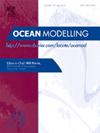Integrating machine learning into a fully coupled current-wave-sediment model: Characterizing particle size in the settling process in estuaries of the great barrier reef, Australia
IF 2.9
3区 地球科学
Q2 METEOROLOGY & ATMOSPHERIC SCIENCES
引用次数: 0
Abstract
Accurate prediction of sediment settling is critical for management of coastal ecosystems, but complex estuarine processes that influence sediment deposition and erosion present a major modelling challenge. This study introduces a proof-of-concept framework that integrates machine learning (ML) into environmental simulations to improve accuracy and efficiency by modelling dynamic sediment flocculation processes and their influence on particle size, enabling a more precise determination of settling velocity. Environmental factors influencing in-situ sediment particle size were used to train a regression model based on coeval measurements of three key parameters: salinity, shear rate and suspended sediment concentration (SSC). This regression model was developed using ML and integrated into a fully coupled current-wave-sediment model to simulate the flocculation response to these three parameters. The integrated model framework demonstrates its reliability and accuracy when evaluated against the in-situ measurements, satellite-derived SSC for the Fitzroy Estuary (Great Barrier Reef), and a parametric flocculation model that only relates settling velocity to SSC. We present an example of the ML-based approach outperforming a parametric model by capturing nonlinear particle-hydrodynamic interactions while maintaining computational efficiency, enabling high-resolution SSC simulations. This work demonstrates an advancement for hybrid modelling using rapidly evolving ML applications, offering a scalable tool for sediment transport and water quality management.
将机器学习集成到一个完全耦合的电流-波浪-沉积物模型中:表征澳大利亚大堡礁河口沉降过程中的粒度
沉积物沉降的准确预测对沿海生态系统的管理至关重要,但影响沉积物沉积和侵蚀的复杂河口过程对建模提出了重大挑战。本研究引入了一个概念验证框架,该框架将机器学习(ML)集成到环境模拟中,通过模拟动态泥沙絮凝过程及其对粒径的影响,提高准确性和效率,从而更精确地确定沉降速度。利用影响原位沉积物粒径的环境因子,基于盐度、剪切速率和悬沙浓度(SSC)三个关键参数的同步估算值,训练了一个回归模型。利用ML建立回归模型,并将其集成到一个完全耦合的电流-波-泥沙模型中,模拟絮凝对这三个参数的响应。综合模型框架在与现场测量、菲茨罗伊河口(大堡礁)卫星导出的SSC和仅将沉降速度与SSC联系起来的参数絮凝模型进行比较时证明了其可靠性和准确性。我们提出了一个基于ml的方法的例子,通过捕获非线性粒子-流体动力相互作用,同时保持计算效率,实现高分辨率的SSC模拟,从而优于参数模型。这项工作展示了使用快速发展的ML应用程序的混合建模的进步,为沉积物运输和水质管理提供了可扩展的工具。
本文章由计算机程序翻译,如有差异,请以英文原文为准。
求助全文
约1分钟内获得全文
求助全文
来源期刊

Ocean Modelling
地学-海洋学
CiteScore
5.50
自引率
9.40%
发文量
86
审稿时长
19.6 weeks
期刊介绍:
The main objective of Ocean Modelling is to provide rapid communication between those interested in ocean modelling, whether through direct observation, or through analytical, numerical or laboratory models, and including interactions between physical and biogeochemical or biological phenomena. Because of the intimate links between ocean and atmosphere, involvement of scientists interested in influences of either medium on the other is welcome. The journal has a wide scope and includes ocean-atmosphere interaction in various forms as well as pure ocean results. In addition to primary peer-reviewed papers, the journal provides review papers, preliminary communications, and discussions.
 求助内容:
求助内容: 应助结果提醒方式:
应助结果提醒方式:


